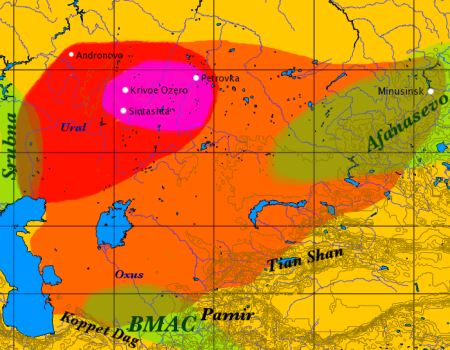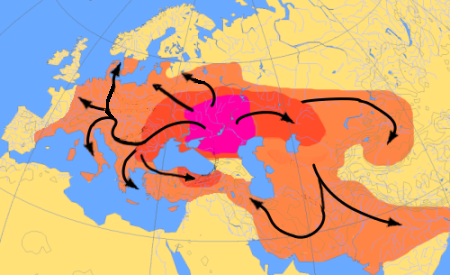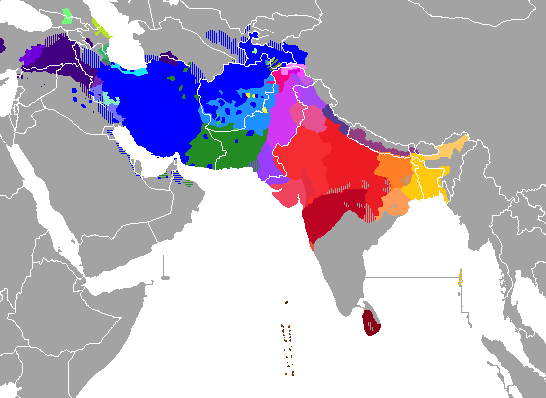INDO
- IRANIANS

The
Sintashta-Petrovka culture (red), expanded into the Andronovo culture
(orange) in the 2nd millennium BC, overlapped the Oxus civilization
(green) in the south, and includes the area of the earliest chariots
(pink).
Indo-Iranian
peoples, also known as Indo-Iranic peoples by scholars, and sometimes
as Arya or Aryans from their self-designation, were a group of Indo-European
peoples who brought the Indo-Iranian languages, a major branch of
the Indo-European language family, to major parts of Eurasia in
the second part of the 3rd millennium BC. They eventually branched
out into Iranian peoples and Indo-Aryan peoples.
Nomenclature
:
The term Aryan has been used historically to denote the Indo-Iranians,
because Arya is the self designation of the ancient speakers of
the Indo-Iranian languages, specifically the Iranian and the Indo-Aryan
peoples, collectively known as the Indo-Iranians. Some scholars
now use the term Indo-Iranian to refer to this group, while the
term "Aryan" is used to mean "Indo-Iranian"
by other scholars such as Josef Wiesehofer, Will Durant, and Jaakko
Häkkinen. Population geneticist Luigi Luca Cavalli-Sforza,
in his 1994 book The History and Geography of Human Genes, also
uses the term Aryan to describe the Indo-Iranians.
Origin
:
The early Indo-Iranians are commonly identified with the descendants
of the Proto-Indo-Europeans known as the Sintashta culture and the
subsequent Andronovo culture within the broader Andronovo horizon,
and their homeland with an area of the Eurasian steppe that borders
the Ural River on the west, the Tian Shan on the east (where the
Indo-Iranians took over the area occupied by the earlier Afanasevo
culture), and Transoxiana and the Hindu Kush on the south.
Based
on its use by Indo-Aryans in Mitanni and Vedic India, its prior
absence in the Near East and Harappan India, and its 19th–20th
century BC attestation at the Andronovo site of Sintashta, Kuzmina
(1994) argues that the chariot corroborates the identification of
Andronovo as Indo-Iranian. Anthony & Vinogradov (1995) dated
a chariot burial at Krivoye Lake to about 2000 BC, and a Bactria-Margiana
burial that also contains a foal has recently been found, indicating
further links with the steppes.
Historical
linguists broadly estimate that a continuum of Indo-Iranian languages
probably began to diverge by 2000 BC, if not earlier, preceding
both the Vedic and Iranian cultures. The earliest recorded forms
of these languages, Vedic Sanskrit and Gathic Avestan, are remarkably
similar, descended from the common Proto-Indo-Iranian language.
The origin and earliest relationship between the Nuristani languages
and that of the Iranian and Indo-Aryan groups is not completely
clear.
Expansion
:

Indo-European
migrations c. 4000 to 1000 BC according to the Kurgan hypothesis.
Magenta indicates the assumed Urheimat (Samara culture, Sredny Stog
culture), red the area which may have been settled by Indo-European-speaking
peoples up to c. 2500 BC, and orange the area to 1000 BC.

Archaeological
cultures associated with Indo-Iranian migrations (after EIEC). The
Andronovo, BMAC and Yaz cultures have often been associated with
Indo-Iranian migrations. The GGC, Cemetery H, Copper Hoard and
PGW cultures are candidates for cultures associated with Indo-Aryan
movements.
Two-wave models of Indo-Iranian expansion have been proposed by
Burrow (1973) and Parpola (1999). The Indo-Iranians and their expansion
are strongly associated with the Proto-Indo-European invention of
the chariot. It is assumed that this expansion spread from the Proto-Indo-European
homeland north of the Caspian sea south to the Caucasus, Central
Asia, the Iranian plateau, and Indian subcontinent. They also expanded
into Mesopotamia and Syria and introduced the horse and chariot
culture to this part of the world.
First
wave – Indo-Aryans :
The Mitanni of Anatolia :
The Mitanni, a people known in eastern Anatolia from about 1500
BC, were of possibly of mixed origins: a Hurrian-speaking majority
was supposedly dominated by a non-Anatolian, Indo-Aryan elite. There
is linguistic evidence for such a superstrate, in the form of :
•
A horse training manual written by a Mitanni man named Kikkuli,
which was used by the Hittites, an Indo-European Anatolian people;
• The names of Mitanni rulers and;
• The names of gods invoked by these rulers in treaties.
In particular, Kikkuli's text includes words such as aika "one"
(i.e. a cognate of the Indo-Aryan eka), tera "three" (tri),
panza "five" (panch), satta "seven", (sapta),
na "nine" (nav), and vartan"turn around", in
the context of a horse race (Indo-Aryan vartan). In a treaty between
the Hittites and the Mitanni, the Ashvin deities Mitra, Varun, Indra,
and Nasatya are invoked. These loanwords tend to connect the Mitanni
superstrate to Indo-Aryan rather than Iranian languages –
i.e. the early Iranian word for "one" was aiva.
Indian
subcontinent – Vedic culture :
The standard model for the entry of the Indo-European languages
into the Indian subcontinent is that this first wave went over the
Hindu Kush, either into the headwaters of the Indus and later the
Ganges. The earliest stratum of Vedic Sanskrit, preserved only in
the Rigved, is assigned to roughly 1500 BC. From the Indus, the
Indo-Aryan languages spread from c. 1500 BC to c. 500 BC, over the
northern and central parts of the subcontinent, sparing the extreme
south. The Indo-Aryans in these areas established several powerful
kingdoms and principalities in the region, from south eastern Afghanistan
to the doorstep of Bengal. The most powerful of these kingdoms were
the post-Rigvedic Kuru (in Kurukshetra and the Delhi area) and their
allies the Pañcalas further east, as well as Gandhar and
later on, about the time of the Buddha, the kingdom of Kosal and
the quickly expanding realm of Magadh. The latter lasted until the
4th century BC, when it was conquered by Chandragupt Maurya and
formed the center of the Mauryan empire.
In
eastern Afghanistan and southwestern Pakistan, whatever Indo-Aryan
languages were spoken there were eventually pushed out by the Iranian
languages. Most Indo-Aryan languages, however, were and still are
prominent in the rest of the Indian subcontinent. Today, Indo-Aryan
languages are spoken in India, Pakistan, Bangladesh, Nepal, Sri
Lanka, Fiji, Suriname and the Maldives.
Second
wave – Iranians :
The second wave is interpreted as the Iranian wave. The first Iranians
to reach the Black Sea may have been the Cimmerians in the 8th century
BC, although their linguistic affiliation is uncertain. They were
followed by the Scythians, who are considered a western branch of
the Central Asian Sakas. Sarmatian tribes, of whom the best known
are the Roxolani (Rhoxolani), Iazyges (Jazyges) and the Alani (Alans),
followed the Scythians westwards into Europe in the late centuries
BC and the 1st and 2nd centuries AD (The Age of Migrations). The
populous Sarmatian tribe of the Massagetae, dwelling near the Caspian
Sea, were known to the early rulers of Persia in the Achaemenid
Period. At their greatest reported extent, around 1st century AD,
the Sarmatian tribes ranged from the Vistula River to the mouth
of the Danube and eastward to the Volga, bordering the shores of
the Black and Caspian seas as well as the Caucasus to the south.
In the east, the Saka occupied several areas in Xinjiang, from Khotan
to Tumshuq.
The
Medians, Persians and Parthians begin to appear on the Iranian plateau
from c. 800 BC, and the Achaemenids replaced Elamite rule from 559
BC. Around the first millennium AD, Iranian groups began to settle
on the eastern edge of the Iranian plateau, on the mountainous frontier
of northwestern and western Pakistan, displacing the earlier Indo-Aryans
from the area.
In
Eastern Europe, the Iranians were eventually decisively assimilated
(e.g. Slavicisation) and absorbed by the Proto-Slavic population
of the region, while in Central Asia, the Turkic languages marginalized
the Iranian languages as a result of the Turkic expansion of the
early centuries AD. Extant major Iranian languages are Persian,
Pashto, Kurdish, and Balochi besides numerous smaller ones. Ossetian,
primarily spoken in North Ossetia and South Ossetia, is a direct
descendant of Alanic, and by that the only surviving Sarmatian language
of the once wide-ranging East Iranian dialect continuum that stretched
from Eastern Europe to the eastern parts of Central Asia.
Archaeology
:
Archaeological cultures associated with Indo-Iranian expansion
include :
•
Europe
• Poltavka culture (2700–2100 BC)
•
Central Asia
• Andronovo horizon (2200–1000 BC)
• Sintashta-Petrovka-Arkaim (2200–1600
BC)
• Alakul (2100–1400 BC)
• Fedorovo (1400–1200 BC)
• Alekseyevka (1200–1000 BC)
• Bactria-Margiana Archaeological Complex
(2200–1700 BC)
• Srubna culture (2000–1100 BC)
• Abashevo culture (1700–1500 BC)
• Yaz culture (1500–1100 BC)
• Indian subcontinent
• Cemetery H culture (1900–1300 BC)
• Swat culture (1600–500 BC)
• Painted Gray Ware culture (1100–350 BC)
• Iran
• Early West Iranian Grey Ware (1500–1000
BC)
• Late West Iranian Buff Ware (900–700 BC)
Parpola (1999) suggests the following identifications :
|
Date
Range |
Archaeological
culture |
Identification
suggested by Parpola |
| 2800
- 2000 BC |
late Catacomb and
Poltavka cultures |
late
PIE to Proto - Indo-Iranian |
| 2000
- 1800 BC |
Srubna
and Abashevo cultures |
Proto-Iranian |
| 2000
- 1800 BC |
Petrovka-Sintashta |
Proto
- Indo-Aryan |
| 1900
- 1700 BC |
BMAC |
"Proto-Dasa"
Indo-Aryans establishing themselves in the existing BMAC settlements,
defeated by "Proto-Rigvedic" Indo-Aryans around 1700 |
| 1900
- 1400 BC |
Cemetery
H |
Indian
Dasa |
| 1800
- 1000 BC |
Alakul-Fedorovo |
Indo-Aryan,
including "Proto - Sauma-Aryan" practicing the Soma cult |
| 1700
- 1400 BC |
early
Swat culture |
Proto-Rigvedic
= Proto-Dardic |
| 1700
- 1500 BC |
late
BMAC |
"Proto
- Sauma-Dasa", assimilation of Proto-Dasa and Proto - Sauma-Aryan |
| 1500
- 1000 BC |
Early
West Iranian Grey Ware |
Mitanni-Aryan
(offshoot of "Proto - Sauma-Dasa") |
| 1400
- 800 BC |
late
Swat culture and Punjab, Painted Grey Ware |
late
Rigvedic |
| 1400
- 1100 BC |
Yaz II-III,
Seistan |
Proto-Avestan |
| 1100
- 1000 BC |
Gurgan
Buff Ware, Late West Iranian Buff Ware |
Proto-Persian,
Proto-Median |
| 1000
- 400 BC |
Iron
Age cultures of Xinjang |
Proto-Saka |
Language
:

Indo-Iranian languages
The Indo-European language spoken by the Indo-Iranians in the late
3rd millennium BC was a Satem language still not removed very far
from the Proto-Indo-European language, and in turn only removed
by a few centuries from Vedic Sanskrit of the Rigved. The main phonological
change separating Proto-Indo-Iranian from Proto–Indo-European
is the collapse of the ablauting vowels *e, *o, *a into a single
vowel, Proto–Indo-Iranian *a (but see Brugmann's law). Grassmann's
law and Bartholomae's law were also complete in Proto-Indo-Iranian,
as well as the loss of the labiovelars (kw, etc.) to k, and the
Eastern Indo-European (Satem) shift from palatized k' to c, as in
Proto–Indo-European *k'Mto- > Indo-Iran. *cata- > Sanskrit
sata-, Old Iran. sata "100".
Among
the sound changes from Proto-Indo-Iranian to Indo-Aryan is the loss
of the voiced sibilant *z, among those to Iranian is the de-aspiration
of the PIE voiced aspirates.
Religion
:
Despite the introduction of later Hindu and Zoroastrian scriptures,
Indo-Iranians shared a common inheritance of concepts including
the universal force *Hrta- (Sanskrit rta, Avestan asha), the sacred
plant and drink *sawHma- (Sanskrit Som, Avestan Haoma) and gods
of social order such as *mitra- (Sanskrit Mitra, Avestan and Old
Persian Mithra, Mitra) and *bhaga- (Sanskrit Bhaga, Avestan and
Old Persian Baga). Proto-Indo-Iranian religion is an archaic offshoot
of Indo-European religion. From the various and dispersed Indo-Iranian
cultures, a set of common ideas may be reconstructed from which
a common, unattested proto-Indo-Iranian source may be deduced.
The
pre-Islamic religion of the Nuristani people and extant religion
of the Kalash people, is mostly based on the original religion of
the Indo-Iranians, some of which are shared with Shinto, one of
the national religions of Japan, which has some Indo-Iranian influence
owing to contact presumably in the steppes of Central Asia at around
2000 BCE. In Shinto, traces of these can be seen in the myth of
the storm god Susanoo slaying a serpent Yamata-no-Orochi and in
the myth of the dawn goddess Ame-no-Uzume.
Development
:
Beliefs developed in different ways as cultures separated and evolved.
For example, the cosmo-mythology of the peoples that remained on
the Central Asian steppes and the Iranian plateau is to a great
degree unlike that of the Indians, focused more on groups of deities
(*daiva and *asura) and less on the divinities individually. [citation
needed] Indians were less conservative [citation needed] than Iranians
in their treatment of their divinities, so that some deities were
conflated with others or, conversely, aspects of a single divinity
developed into divinities in their own right. By the time of Zoroaster,
Iranian culture had also been subject to the upheavals of the Iranian
Heroic Age (late Iranian Bronze Age, 1800–800 BC [citation
needed]), an influence that the Indo-Aryans were not subject to.[citation
needed]
Sometimes
certain myths developed in altogether different ways. The Rig-Vedic
Sarasvati is linguistically and functionally cognate with Avestan
*Haraxvaiti Ar?duui Sura Anahita [citation needed]. In the Rig-Ved
(6,61,5–7) she battles a serpent called Vritra, who has hoarded
all of the Earth's water. In contrast, in early portions of the
Avesta, Iranian *Harahvati is the world-river that flows down from
the mythical central Mount Hara. But *Harahvati does no battle —
she is blocked by an obstacle placed there by Angra Mainyu.
Cognate
terms :
The following is a list of cognate terms that may be gleaned from
comparative linguistic analysis of the Rigved and Avesta. Both collections
are from the period after the proposed date of separation (c. 2nd
millennium BC) of the Proto-Indo-Iranians into their respective
Indic and Iranian branches.
|
Indo-Iranian |
Particulars |
| *
Hapš |
Vedic
Sanskrit : Ap
Avestan
: Ap
Common
meaning :
"water," apas "the
Waters" |
| *
Hapam Napats |
Vedic
Sanskrit : Apam Napat, Apam Napat
Avestan
: Apam Napat
Common
meaning :
The
"water's offspring"
|
| *
Aryaman |
Vedic
Sanskrit : Aryaman
Avestan
: Airyaman
Common
meaning :
"Arya-hood"
(lit:** "member of Arya community")
|
| *
Hr?tas |
Vedic
Sanskrit : Rta
Avestan
: Asha/arta
Common
meaning :
"active
truth", extending to "order" & "righteousness"
|
| *
Atharwan |
Vedic
Sanskrit : Atharvan
Avestan
: Aϑrauuan, Aϑaurun
Common
meaning :
"priest"
|
| *Haj?iš |
Vedic
Sanskrit : Ahi
Avestan
: Azhi, (aži)
Common
meaning :
"dragon,
snake", "serpent"
|
| *
Daywas |
Vedic
Sanskrit : Daiva, Dev
Avestan
: Daev, (daeuua)
Common
meaning :
A
class of divinities
|
| *
Manu |
Vedic
Sanskrit : Manu
Avestan
: Manu
Common
meaning :
"man"
|
| *
Mitra |
Vedic
Sanskrit : Mitra
Avestan
: Mithra, Miϑra
Common
meaning :
"oath,
covenant"
|
| *
Hasuras |
Vedic
Sanskrit : Asur
Avestan
: Ahur
Common
meaning :
Another
class of spirits
|
| *
Sarwatat |
Vedic
Sanskrit : Sarvatat
Avestan
: Hauruuatat
Common
meaning :
"intactness",
"perfection"
|
| *
Saraswati |
Vedic
Sanskrit : Sarasvati
Avestan
: Haraxvaiti (Areduui Sura Anahita)
Common
meaning :
A
controversial (generally considered mythological) river,
a river goddess
|
| *
Sawmas |
Vedic
Sanskrit : Sauma, Som
Avestan
: Haom
Common
meaning :
A
plant, Deified
|
| *
Suhar ~ * Suhr |
Vedic
Sanskrit : Svar
Avestan
: Hvar, Xvar
Common
meaning :
The
Sun, also cognate to Greek helios, Latin sol,
Engl. Sun
|
| *
Top ~ * Tep |
Vedic
Sanskrit : Tapati
Avestan
: Tapaiti
Common
meaning :
Possible
fire/solar goddess; see Tabiti (a possibly Hellenised Scythian theonym).
Cognate with Latin tepeo and several other terms.
|
| *
Wrtras |
Vedic
Sanskrit : Vrtra-
Avestan
: Verethra, vereϑra (cf. Verethragna,
Vereϑraγna)
Common
meaning :
"obstacle"
|
| *
Yamas |
Vedic
Sanskrit : Yam
Avestan
: Yim
Common
meaning :
Son
of the solar deity Vivasvant/Viuuahuuant
|
| *
Yagnas |
Vedic
Sanskrit : Yagña
Avestan
: Yasna, object: yazata
Common
meaning :
"worship,
sacrifice, oblation"
|
Genetics
:
R1a1a (R-M17 or R-M198) is the sub-clade most commonly associated
with Indo-European speakers. Most discussions purportedly of R1a
origins are actually about the origins of the dominant R1a1a (R-M17
or R-M198) sub-clade. Data so far collected indicates that there
are two widely separated areas of high frequency, one in the northern
Indian subcontinent, and the other in Eastern Europe, around Poland
and Ukraine. [citation needed] The historical and prehistoric possible
reasons for this are the subject of on-going discussion and attention
amongst population geneticists and genetic genealogists, and are
considered to be of potential interest to linguists and archaeologists
also.
Out
of 10 human male remains assigned to the Andronovo horizon from
the Krasnoyarsk region, 9 possessed the R1a Y-chromosome haplogroup
and one C-M130 haplogroup (xC3). mtDNA haplogroups of nine individuals
assigned to the same Andronovo horizon and region were as follows:
U4 (2 individuals), U2e, U5a1, Z, T1, T4, H, and K2b.
A
2004 study also established that during the Bronze Age/Iron Age
period, the majority of the population of Kazakhstan (part of the
Andronovo culture during Bronze Age), was of west Eurasian origin
(with mtDNA haplogroups such as U, H, HV, T, I and W), and that
prior to the 13th–7th century BC, all Kazakh samples belonged
to European lineages.
Source
:
https://en.wikipedia.org/
wiki/Indo-Iranians




